Some algae can decorate your aquarium, while others may be harmful. In general, excessive nutrients, nitrates, and organic substances will provide an ideal habitat for algae. To make good use of aquarium algae, we will give you ideas of common algae in freshwater aquariums in this article. Meanwhile, we will also provide methods to deal with harmful algae.
Content Table
Common Algae Species
To better understand algae species, we will learn about the common algae types in freshwater aquariums in this part.
1. Green algae
(1) Hazard rating: low
(2) Causes
- High nitrate level
- Excessive nutrients
(3) Location: the substrate, rocks, or other surfaces
(4) Significance
- protect fish from chafing on the aquarium glass
- a food source with high nutrient levels
- purify water quality
2. Green water
(1) Hazard rating: low
(2) Causes
- The proliferation of free-floating and single-celled phytoplankton
- Excessive levels of nitrates and phosphates
(3) Location: water in aquariums
(4) Significance: absorb ammonia
3. Brown diatom algae
(1) Hazard rating: low
(2) Causes
- Lasting low light
- High levels of silicates and phosphates
(3) Location: aquarium glass, substrate, plants, and other surfaces
(4) Significance: a food source for shrimp, snails, and other otocinclus catfish
4. Green spot algae (GSA)
(1) Hazard rating: medium
(2) Causes
- The imbalance between nitrates and phosphates (main cause: the shortage of phosphates)
- Too much light: intense light and lighting for a long time
(3) Location: aquarium glass, leaves of aquatic plants, and substrate
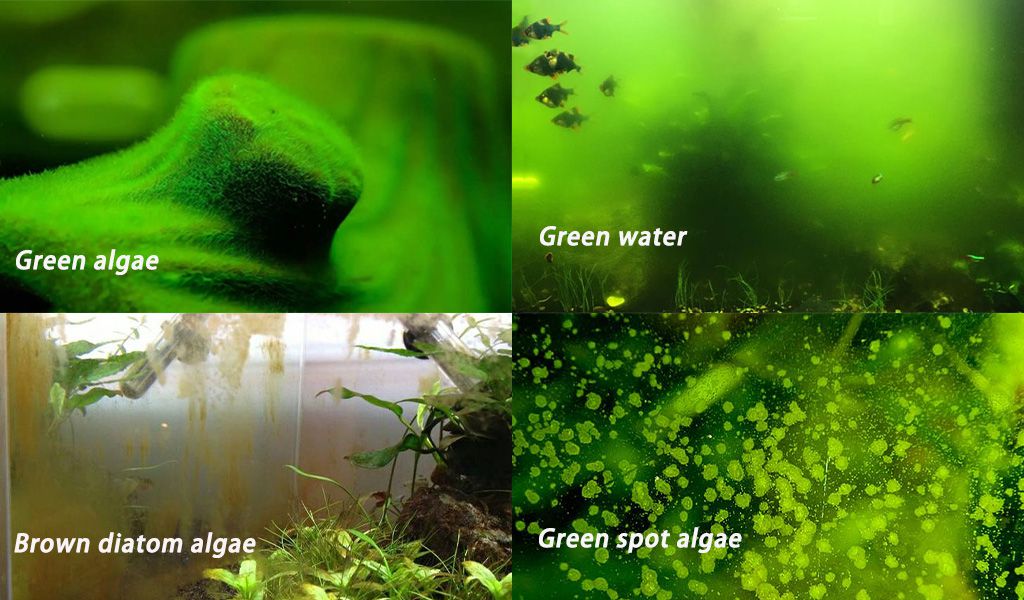
5. Chladophora
(1) Hazard rating: medium
(2) Causes: the imbalance between light and carbon dioxide (intense light & shortage of carbon dioxide)
(3) Location: substrate, wood, or aquatic plants
6. Filamentous algae
(1) Hazard rating: low
(2) Causes
- Entering the fish tank and attaching plants, fish, and aquarium supplies
- Too much light: intense light or lighting for a long time
- Excessive nutrients: plenty of trace elements and nitrates
- Do not change the water regularly and timely
(3) Location
- Attaching to rocks, wood, aquatic plants
- Floating to the water’s surface
(4) Significance:
- Remove ammonia
- Purify the water
If you want to learn more about how to deal with filamentous algae, please go to Filamentous Algae Killer Clean Shrimps.
7. Blue-green algae (BGA)
(1) Hazard rating: high
(2) Causes
- Excessive nutrients
- High levels of ammonia and phosphate
- Low nitrate level
(3) Location: plants, substrate, or aquarium decorations
8. Green dust algae (GDA)
(1) Hazard rating: medium
(2) Causes
- The imbalance between calcium and magnesium
- High phosphate level but low nitrate level
(3) Location: aquarium glass, stones surfaces
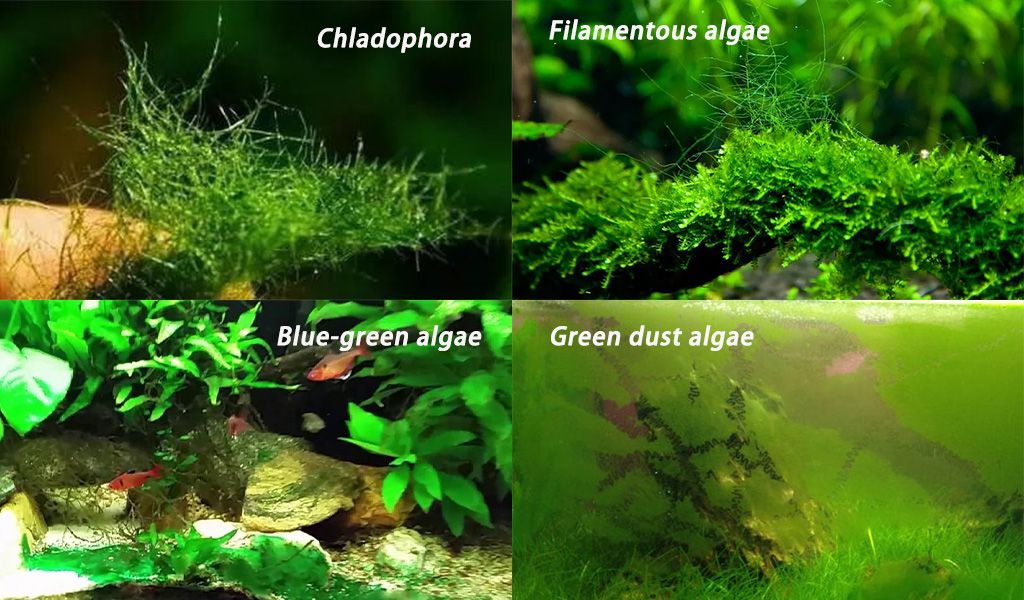
9. Staghorn algae
(1) Hazard rating: medium
(2) Causes
- High ammonia level
- Low carbon dioxide
- Hard water
(3) Location: leaves of aquatic plants and wood
10. Black beard algae (BBA)
(1) Hazard rating: high
(2) Causes
- Entering the fish tank and attaching plants, fish, and aquarium accessories
- Poor maintenance: as the accumulation of feces, uneaten food, organics, and other debris, the water quality becomes poor
- Low or unstable levels of carbon dioxide
- Too much light: excessive lighting and lighting lasting for a long time
(3) Location
- Attachment one: rocks, stones, or the edges or the whole of aquatic plants’ leaves
- Floating one: gravel, stones, rocks, wood, as well as the inlet and outlet of the aquarium filter
11. Spirogyra
(1) Hazard rating: low
(2) Causes
- High levels of ammonia, nitrate, and phosphate
- Intense light
(3) Location: substrate
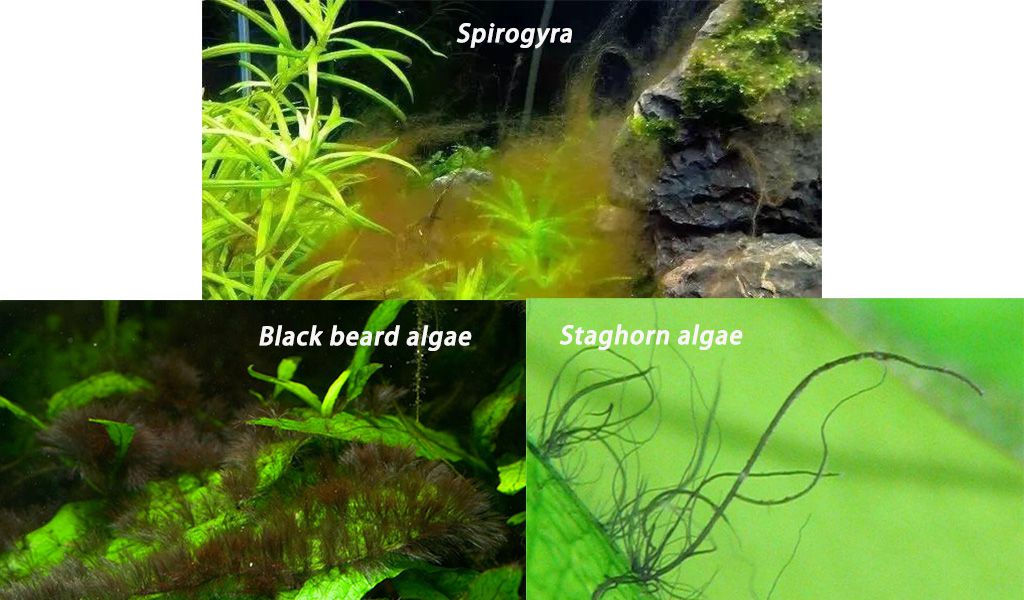
Major Algae Types in Freshwater Tanks
In this segment, we will get into a specific discussion about major algae types in freshwater tanks, including information about the algae, the hazard rating, and methods to deal with them.
1. Black beard algae (BBA)
Black beard algae are abbreviated as BBA, and their scientific name is Audouinella. They are one kind of algae from the red algae family and have colors in black, dark green, and dark red. As we have mentioned above, there are two main growth types, including attachment and floating. In addition, black beard algae are harmful to your aquarium. On the one hand, they will block the light, which is essential for aquatic plants. The algae are fatal for fish, too. Therefore, removing black beard algae as soon as possible is recommended once you find them in your tank.
In addition, there are also methods to prevent or remove the black beard algae from your aquarium.
- Keep everything clean
Check the aquarium accessories and new fish before adding them to tanks. Before introducing new fish, you can also quarantine them in another tank for about 2 weeks. If there are black beard algae, you can scoop them with a fish net.
- Keep oxygen enough
Since the black beard algae thrive under low carbon dioxide environments, keeping plenty of oxygen is critically essential. Meanwhile, you should check the level of carbon dioxide once you find the algae in your tank.
- Keep ideal lighting
Lighting with high intensity or lasting for a long time will accelerate the spread of black beard algae. It is recommended to keep the aquarium light on for about 8-10 hours per day. And you can adjust the light intensity according to the plants and fish in your aquarium.
- Prune with tools
The easiest method is to trim off the leaves with black beard algae. On the other hand, you can remove the algae from rocks with a toothbrush or an algae scraper. Then, siphon a fish tank to remove the algae and detritus from your tank.
- Apply bleach
If the algae take the dominant place, pulling and treating aquatic plants and wood will be required. To kill the black beard algae and keep the aquatic plants alive, it is feasible to soak everything in a 10% bleach solution for three minutes.
- Introducing algae-eaters
Algae can be a food source for some fish and invertebrates. Algae-eaters, Siamese algae eaters, and Amano shrimp for instance will consume black beard algae.
2. Blue-green algae
Blue-green algae are close to green algae in appearance. However, they are signals of poor water quality. They are not algae exactly, but cyanobacteria. In addition to this, they contain chlorophyll, therefore, they can photosynthesize and live by themselves. They like covering the plants, substrate, or aquarium decorations, just like a blanket. On the other hand, blue-green algae can also be brown and black.
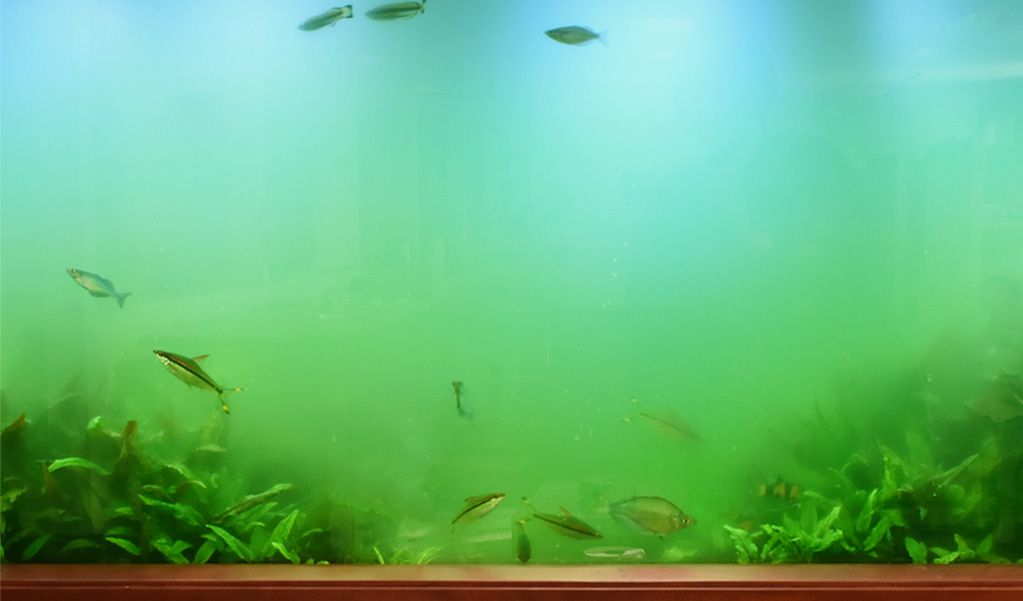
algae in aquarium
Furthermore, you can remove them by applying an air stone and aquarium filter. If it does not work, removing them with your hands is an excellent option. In addition to this, you can also add erythromycin. The treatment dose is 200mg per 38 liters of water for 5 consecutive days. Nonetheless, if you want to kill blue-green algae, you can add 2.5 ppm for 4 consecutive days. One more tip here, it is better not to use the algaecide. The dead algae will decompose toxic substances, which will make fish and shrimp poisoned and even die.
3. Chladophora
Chladophora looks like moss, featuring filamentous. They are thin and hard. The algae contain chlorophyll as high as plants in high ranking. Chladophora grows on the substrate, rocks, wood, or aquatic plants. However, the algae usually grow in one concentrated place, and they can be removed easily.
Seeing that the chladophora is harmful, how to prevent or get rid of it? First of all, because chladophora is hard, thus, remove by your hand is an excellent and effective option. Besides, if there is no sufficient carbon dioxide, it is recommended to reduce the light. Aside from that, adding a strong glutaral solution is a great choice. The treatment dose should be 5 ml of 2% strong glutaral solution per 40 liters of water each day. If it does not work, you can add more accordingly.
4. Staghorn algae
Staghorn algae belong to the red algae family and are a compsopogon species. Their branches feature the shape of the antlers of a stag. If you want to remove staghorn algae, you can choose a glutaral solution. The prophylactic dose is 5 ml of 2% glutaral solution per 200 liters of water each day. On the other hand, the treatment dose should be 5ml of 2% glutaral solution per 40 liters of water each day.
5. Green dust algae (GDA)
Green dust algae are zoospores, which mainly grow on aquarium glass, and they even cover the whole glass. The algae prefer intense light. Green dust algae can attach to the aquarium glass again after floating in the water for 30-90 minutes. Thus, scraping the algae from the glass may not make sense. Nevertheless, you can dim the light intensity, while adding potassium nitrate. The amount of potassium nitrate should be 1mg per liter. After three weeks, the green dust algae will be killed.
In summary, there are four main methods to get rid of algae in your tank.
- Tools: hands, toothbrush, aquarium cleaner tools, algae scraper
- Biological treatment: introducing algae eaters, such as Amano shrimp, snails, and siamese algae eater
- Algaecide: glutaral solution for example
- Germicidal lamp: kill algae spores
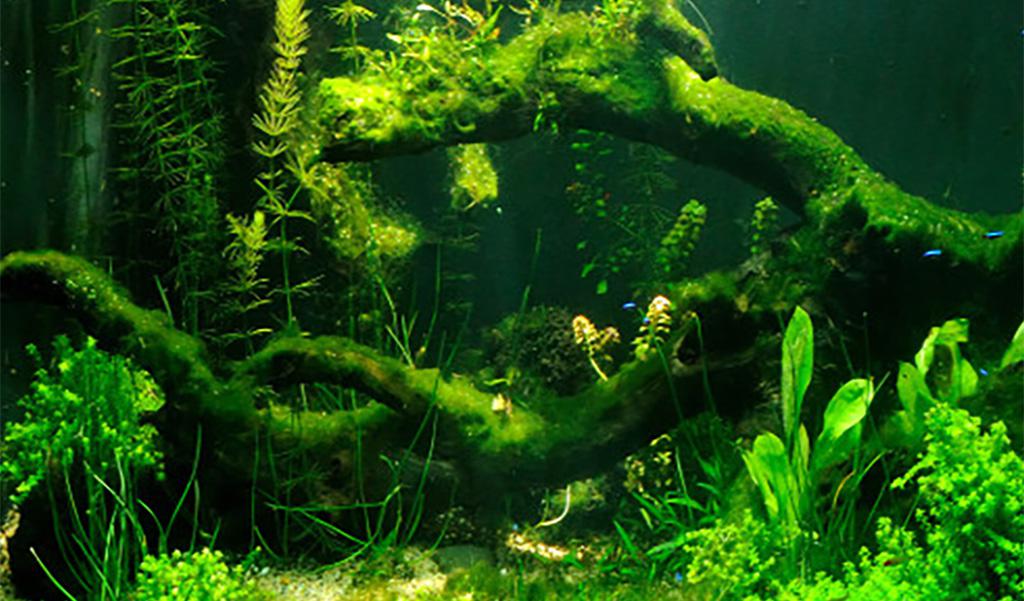
algae in fish tank
Are All Algae Blooms Harmful?
Not all algae blooms are harmful. It depends on the algae species exactly. Blue-green algae bloom will produce cyanotoxins, which can make your fish sick. Consequently, the blue-green algae blooms are harmful. On the contrary, green algae bloom should be beneficial. They can cover the aquarium, like a green carpet.
In addition to this, you can control the algae by adjusting the color temperature and water temperature, since the ideal of the two respectively is 5700-7500K and 68-86℉. Besides, you can also decrease the nitrate level by keeping the aquarium light on for less than 8 hours per day. Also, you can remove green algae with an aquarium cleaner tool kit.
Reminder
In summary, here are some pointers about algae for decorating your aquarium, green algae for example. Green algae are the best to decorate aquariums. The algae grow slowly but firmly, and they are soft. They can protect your fish from chafing on the aquarium glass. Besides, they are good-looking, while they also taste good with high nutrient levels as they can help purify water quality, and you can even decorate the aquarium with green algae.
After reading, we hope you have learned more about algae in freshwater aquariums. Is this article helpful? It is feasible to share with your friends. If you have any interesting ideas, welcome to share them with us in the comment. Finally, thanks for your reading!
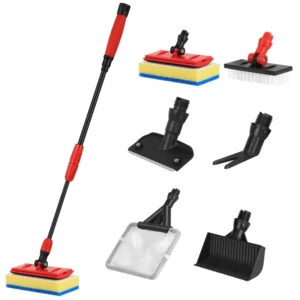
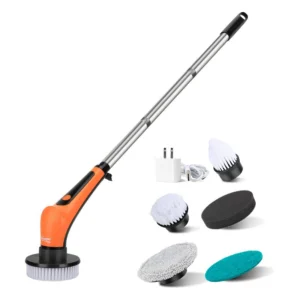
Leave a comment